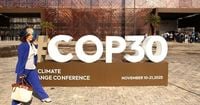As the world’s attention turns once more to the Amazonian city of Belém, Brazil, the 30th United Nations Climate Change Conference—COP30—has reached its halfway mark, and the stakes could hardly be higher. From November 6 to November 21, 2025, leaders, scientists, activists, and negotiators have gathered to tackle the ever-more-urgent challenge of limiting global warming to 1.5°C, a target that, according to many, is slipping out of reach.
But has the world truly given up on fighting climate change? That provocative question, recently posed by The New York Times, lingers in the air as delegates debate, protestors march, and the planet continues to break heat records. The answer, it seems, depends on whether the pledges made in Belém can be transformed into concrete, lasting action—or whether COP30 will be remembered as yet another missed opportunity.
From the outset, the summit has been marked by a sense of urgency and frustration. “The world is moving in the right direction but at the wrong speed,” said Brazil’s President Luiz Inácio Lula da Silva in his opening address, setting a somber but determined tone echoed by United Nations Secretary-General António Guterres. Guterres, addressing the plenary, warned, “The hard truth is that we have failed to ensure we remain below 1.5 degrees. Science now tells us that a temporary overshoot beyond the 1.5 limit—starting at the latest in the early 2030s—is inevitable. We need a paradigm shift to limit this overshoot’s magnitude and duration and quickly drive it down. Even a temporary overshoot will have dramatic consequences. It could push ecosystems past irreversible tipping points, expose billions to unlivable conditions, and amplify threats to peace and security. Every fraction of a degree means more hunger, displacement, and loss—especially for those least responsible. This is moral failure, and deadly negligence.”
Despite these warnings, the first week of negotiations has ended with little to show in the way of firm commitments. According to Mongabay, negotiators have struggled to turn broad promises on finance, adaptation, and loss and damage into concrete agreements. The summit’s success, many agree, will hinge on whether countries can reach consensus on a robust finance roadmap, clearer adaptation rules, and faster access to loss and damage funds—measures that would demonstrate the meeting can deliver more than just speeches.
Central to these discussions is the so-called Baku-to-Belém Roadmap, a plan introduced by last year’s and current hosts aiming to raise $1.3 trillion annually by 2035. The roadmap proposes reforms to development banks, reducing debt pressure, and attracting more private capital. Yet, as the World Resources Institute points out, some of the most urgent needs—such as preparing communities for rising heat and supporting those affected by disasters—are unlikely to attract private investment. These areas, known as adaptation and loss and damage, remain the least funded, despite being crucial for the world’s most vulnerable populations.
The issue of climate finance has become a flashpoint. According to a joint report by Oxfam and the CARE Climate Justice Centre, developing countries are now paying back more in climate finance loans than they receive. For every five dollars received, they repay seven, with 65% of funding delivered as loans. “Rich countries are treating the climate crisis as a business opportunity, not a moral obligation. They are lending money to the very people they have historically harmed, trapping vulnerable nations in a cycle of debt. This is a form of crisis profiteering,” said Nafkote Dabi, Oxfam’s Climate Policy Lead. The debt burden for developing nations now stands at $3.3 trillion, while Least Developed Countries received just 19.5% and Small Island Developing States a mere 2.9% of total public climate finance in 2021-2022—half of it as loans.
Meanwhile, the technical details of mitigation—cutting greenhouse gases—are also proving contentious. Delegates are debating how to encourage cleaner power systems, reduce methane leaks, and set clear targets for emission reductions. Methane, after all, is about 28 times more potent than carbon dioxide as a greenhouse gas. Yet, a recent UN report indicates that the world is not on track to meet its methane emission reduction goals, adding to the sense of urgency.
Politics and posturing have shaped much of the first week. Some leaders have used the summit to restate long-held positions, with calls for richer nations to provide more support and for all countries to do more to cut emissions. Notably, the absence of leaders from major emitters such as India, Russia, the US, and China has cast a shadow over the proceedings. UK Prime Minister Sir Keir Starmer acknowledged the waning political consensus, stating, “Today sadly that consensus is gone.”
Outside the negotiating rooms, civil society groups have raised concerns about the large number of fossil fuel lobbyists present at the summit, as well as the limited space for indigenous peoples and frontline communities. These groups argue that meaningful participation is essential for fair climate decisions, but this year, access has been restricted and negotiation rooms have been crowded. “People must be very concerned that governments, especially Western countries that bear most of the responsibility for the climate crisis, are far from fulfilling their commitments,” said Anuradha Mittal, Executive Director of The Oakland Institute. She criticized what she described as “false climate solutions such as carbon markets, which have been proven to be totally ineffective at reducing emissions.”
The scientific community, too, has sounded the alarm. The State of Climate Action 2025 report by the World Resources Institute found that none of the key economic sectors is moving fast enough to keep planetary warming within safer levels. Other research indicates that current national plans would still result in dangerous levels of heating, prompting negotiators to seek ways to close the gap between rhetoric and reality.
Despite the slow progress, there have been some encouraging signs. A new group of finance ministers is exploring ways to support the roadmap, and development banks have shown interest in more coordinated action. Several countries have indicated a willingness to consider longer-term funding models, which could reduce uncertainty. Environmentalist Keith Tuffley has highlighted the dire need for financing global forest protection, noting, “Forests are disappearing at the rate of 10 million hectares a year. To stay on track for 1.5°C, UNEP estimates that tropical regions need $66.8 billion in annual investment in forests by 2030.”
Prince William, present at COP30, urged leaders to act for the sake of future generations: “Let us rise to this moment with the clarity that history demands of us. Let us be the generation that turned the tide—not for applause, but for the quiet gratitude of those yet to be born.”
As COP30 enters its crucial second week, the world is watching to see whether negotiators can bridge the gap between promises and performance. Will Belém be remembered as the summit where talk finally gave way to action—or as another lost chance in a world running out of time?


